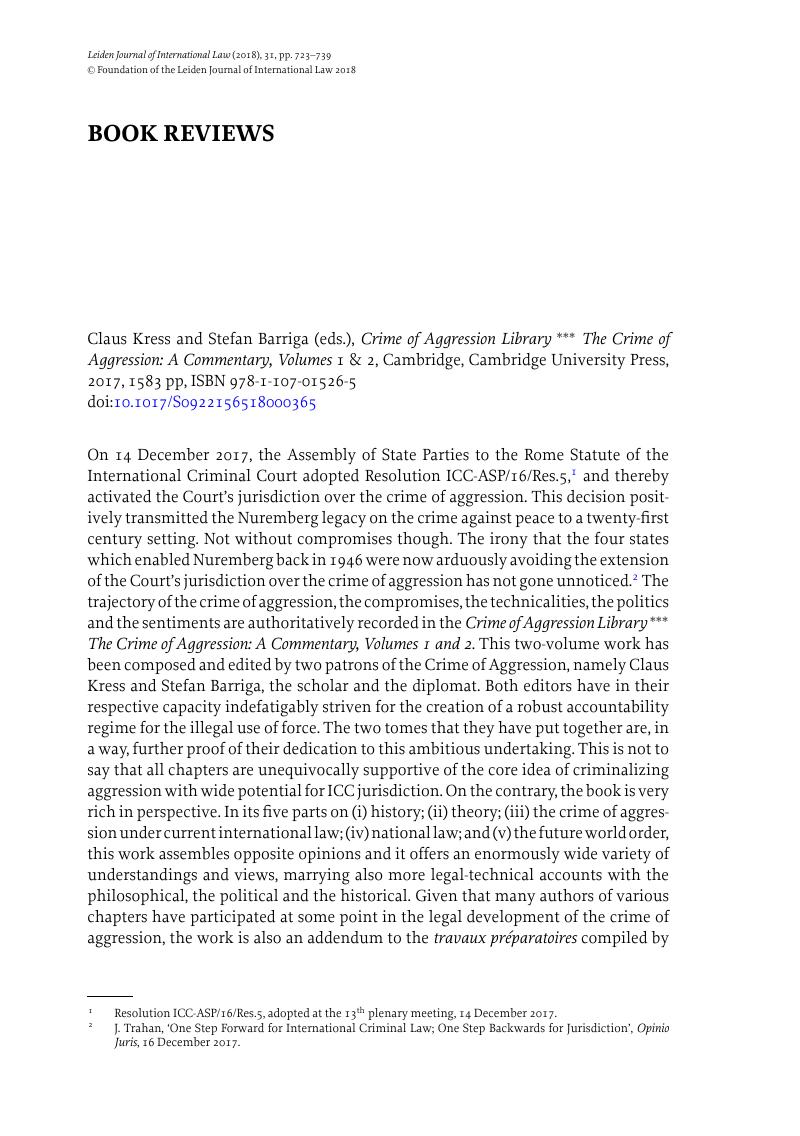No CrossRef data available.
Published online by Cambridge University Press: 11 June 2018

Vice Dean of Leiden Law School and Professor of Public International Law at the Grotius Centre for International Legal Studies, Leiden University [L.van.den.Herik@LAW.leidenuniv.nl].
1 Resolution ICC-ASP/16/Res.5, adopted at the 13th plenary meeting, 14 December 2017.
2 J. Trahan, ‘One Step Forward for International Criminal Law; One Step Backwards for Jurisdiction’, Opinio Juris, 16 December 2017.
3 S. Barriga and C. Kress, The Travaux Préparatoires of the Crime of Aggression (2011).
4 See, e.g., on the discussion of applying the attempt provision of Art. 25(3)(f) of the ICC Statute to the crime of aggression and how this discussion was intertwined with or distorted by discussions on the role of the Security Council, Clark, R., ‘General Principles of International Criminal Law’, in Kress, C. and Barriga, S. (eds.), The Crime of Aggression: A Commentary (2017), 615Google Scholar. See also, at 618, where Clark explains that ‘as one of those involved in the drafting of the Elements, I did not see Element 3 as addressed at all to the question of attempts’.
5 K. Sellars, ‘The First World War, Wilhelm II and Article 227: The Origin of the Idea of “Aggression” in International Criminal Law’ (Ch. 1); C. McDougall, ‘The Crime against Peace Precedent’ (Ch. 2); K. Sellars, ‘The Legacy of the Tokyo Dissents on “Crimes against Peace” (Ch. 3); T. Bruha, ‘The General Assembly's Definition of the Act of Aggression’ (Ch. 4).
6 Ibid., at 77 and 105.
7 Ibid., at 173.
8 N. Strapatsas, ‘The Practice of the Security Council Regarding the Concept of Aggression’ (Ch. 5).
9 S. Barriga and N. Blokker, ‘Entry into Force and Conditions for the Exercise of Jurisdiction: Cross-Cutting Issues’ (Ch. 17) and ‘Conditions for the Exercise of Jurisdiction based on Security Council Referrals’ (Ch. 18).
10 D. Akande and A. Tzanakopoulos, ‘The International Court of Justice and the Concept of Aggression’ (Ch. 6).
11 Ibid., at 229.
12 C. Kress, ‘The State Conduct Element’ (Ch. 14).
13 See, e.g., McDougall, ‘Article 8bis papers over rather than resolved debates on the contours of prohibition of use of force’; C. McDougall, ‘The Crime against Peace Precedent’, in Kress and Barriga, supra note 4, cf fn. 5, at 125.
14 M. Koskenniemi, ‘A Trap for the Innocent. . .’ (Ch. 49).
15 Paulus, A., ‘Second thoughts on aggression’, (2009) 20 EJIL 1117–28, at 1124CrossRefGoogle Scholar.
16 A. Peters, ‘The Turkish Operation in Afrin (Syria) and the Silence of the Lambs’, EJIL: Talk!, 30 January 2018, available at www.ejiltalk.org/?s=silence+of+the+lambs.
17 2018 Nuclear Posture Review, Department of Defence, US, February 2018, at 21: ‘The United States would only consider the employment of nuclear weapons in extreme circumstances to defend the vital interests of the United States, its allies, and partners. Extreme circumstances could include significant non-nuclear strategic attacks. Significant non-nuclear strategic attacks include, but are not limited to, attacks on the U.S., allied, or partner civilian population or infrastructure, and attacks on U.S. or allied nuclear forces, their command and control, or warning and attack assessment capabilities’ (emphasis added).
18 The idea of a pre-emptive, limited attack on North Korean nuclear missile arsenal and infrastructure, also called the bloody nose option was considered by Trump in February 2018. Defense Minister Mattis warned that war with North Korea would be ‘catastrophic’ – ‘probably the worst kind of fighting in most people's lifetimes’, New York Times, 3–4 February 2018, at 5 (‘White House presses for new options on North Korea’).
19 C. Kress, ‘Introduction: The Crime of Aggression and the International Legal Order’, in Kress and Barriga, supra note 4, at 7, footnote 34.
20 In the order of the chapters 33–47: M. Biato and M. Böhlke, Brazil; Zhou Lulu, China; E. Belliard, France; S. Wasum-Rainer, Germany; N. Singh, India; Djamchid Momtaz and E. Baghaei Hamaneh, Iran; R.S. Schöndorf and D. Geron, Israel; I. Komatsu, Japan; Y. Sok Kim, South Korea; R. Einar Fife, Norway; G. Kuzmin and I. Panin, Russia; A. Stemmet, South Africa; C. Whomersley, UK; H.H. Koh and T.F. Buchwald, US; N. Negm, Egypt.
21 N. Weisbord, ‘Civil Society’ (Ch. 48).
22 W. Schabas, ‘Aggression and International Human Rights Law’ (Ch. 12).
23 F. Mégret, ‘What is the Specific Evil of Aggression?’ (Ch. 51), see also specifically at 1425.
24 Ibid., at 1434.
25 Ibid., at 1445.
26 Ibid., at 1437.
27 L. May, ‘Just War Theory and the Crime of Aggression’ (Ch. 9). See also references in footnote 5 and 20.
28 E. Pobjie, ‘Victims of the Crime of Aggression’ (Ch. 23).
29 E. Chaitidou, F. Eckelmans and B. Roche, ‘The Judicial Function of the Pre-Trial Division’ (Ch. 22).